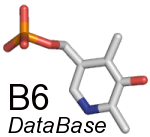|
|
| |
2.6.1.103 |
| Description |
(S)-3,5-dihydroxyphenylglycine transaminase |
| Alternative names |
(S)-3,5-dihydroxyphenylglycine transaminase.
L-p-hydroxyphenylglycine transaminase.
(S)-4-hydroxyphenylglycine amino transferase.
HpgT (gene name) |
| Catalyzed reaction |
(S)-3,5-dihydroxyphenylglycine + 2-oxoglutarate = 2-(3,5-dihydroxyphenyl)-2-oxoacetate + L-glutamate.
(S)-4-hydroxyphenylglycine + 4-hydroxyphenylpyruvate = 4-hydroxyphenyl-2-oxoacetate + L-tyrosine
|
| Cofactor |
Pyridoxal-phosphate. |
| Comments |
The enzyme from the bacterium Amycolatopsis orientalis catalyses the first reaction in the reverse direction as part of the biosynthesis of the (S)-3,5-dihydroxyphenylglycine constituent of the glycopeptide antibiotic chloroeremomycin. |
| |
The enzyme from Amycolatopsis orientalis also transaminates L-4-hydroxyphenylglycine (second of the reactions above) and is involved in the synthesis of chloroeremomycin. A similar, characterized enzyme from Streptomyces lavendulae also transaminates L-4-hydroxyphenylglycine and acts in the pathway for the production of complestatin. These enzymes do not use D-p-hydroxyphenylglycine as a substrate and thus are totally distinct from EC 2.6.1.72. |
| Organisms |
-Eubacteria |
| | |
|---|
Family |
|
| | |
|---|
| Links |
Enzyme (activities) 2.6.1.103
BRENDA (activities) 2.6.1.103
KEGG (pathways) 2.6.1.103
PLPMDB (PLP mutants) 2.6.1.103
|
| | |
|---|
| References |
Tan B, Zhang Q, Zhu Y, Jin H, Zhang L, Chen S, Zhang C (2020) Deciphering Biosynthetic Enzymes Leading to 4-Chloro-6-Methyl-5,7-Dihydroxyphenylglycine, a Non-Proteinogenic Amino Acid in Totopotensamides
ACS Chem Biol in press. Chiu, H. T.; Hubbard, B. K.; Shah, A. N.; Eide, J.; Fredenburg, R. A.; Walsh, C. T.; Khosla, C. (2001) Molecular cloning and sequence analysis of the complestatin biosynthetic gene cluster Proc Natl Acad Sci U S A 98 8548-53. Pfeifer V, Nicholson GJ, Ries J, Recktenwald J, Schefer AB, Shawky RM, Schröder J, Wohlleben W, Pelzer S (2001) A polyketide synthase in glycopeptide biosynthesis: the biosynthesis of the non-proteinogenic amino acid (S)-3,5-dihydroxyphenylglycine J Biol Chem 276 38370-7. Sandercock, A.M., Charles, E.H., Scaife, W., Kirkpatrick, P.N., O'Brien, S.W., Papageorgiou, E.A., Spencer, J.B., Williams, D.H. (2001) Biosynthesis of the di-meta-hydroxyphenylglycine constituent of the vancomycin-group antibiotic chloroeremomycin Chem Commun 2001 1252-1253. Hubbard BK, Thomas MG, Walsh CT. (2000) Biosynthesis of L-p-hydroxyphenylglycine, a non-proteinogenic amino acid constituent of peptide antibiotics
Chem Biol 7 931-42. |
| | |
|---|
| last changed |
2019/05/17 10:02 |
|











